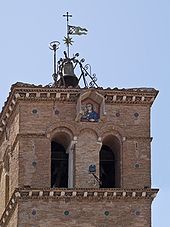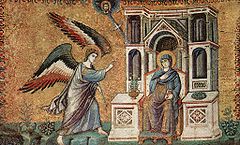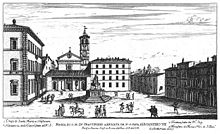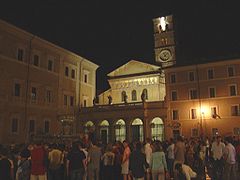- Santa Maria in Trastevere
-
Basilica of Our Lady's in Trastevere
Basilica di Santa Maria in Trastevere (Italian)
Façade of Santa Maria in Trastevere
Basic information Location  Rome, Italy
Rome, ItalyGeographic coordinates 41°53′22″N 12°28′11″E / 41.88944°N 12.46972°ECoordinates: 41°53′22″N 12°28′11″E / 41.88944°N 12.46972°E Affiliation Roman Catholic Ecclesiastical or organizational status Minor basilica Leadership Józef Glemp Architectural description Architect(s) Carlo Fontana Architectural type Church Direction of façade E Groundbreaking 4th century Completed 1143 Specifications Length 56 metres (184 ft) Width 30 metres (98 ft) Width (nave) 16 metres (52 ft) The Basilica of Our Lady in Trastevere (Italian: Basilica di Santa Maria in Trastevere) is a titular minor basilica, one of the oldest churches in Rome, and perhaps the first in which mass was openly celebrated. The basic floor plan and wall structure of the church date back to the 340s AD.
Contents
History
The inscription on the episcopal throne states that it is the first church dedicated to the Mother of God, although some claim that privilege belongs to the Basilica di Santa Maria Maggiore. In its founding it is certainly one of the oldest churches in the city. A Christian house-church was founded here about 220 by Pope Saint Callixtus I (217-222) on the site of the Taberna meritoria, an asylum for retired soldiers. The area was given over to Christian use by the Emperor Septimius Severus when he settled a dispute between the Christians and tavern-keepers, saying, according to the Liber Pontificalis "I prefer that it should belong to those who honor God, whatever be their form of worship." In 340 Pope Julius I (337-352) rebuilt the titulus Callixti on a larger scale, and it became the titulus Iulii commemorating his patronage, one of the original twenty-five parishes in Rome; indeed it may be the first church in which Mass was celebrated openly.
It underwent two restorations in the fifth and eighth centuries. In 1140-43 the church was re-erected on its old foundations under Pope Innocent II.[1] Innocent II razed the church to the ground, along with the recently completed tomb of his former rival, Pope Anacletus II, and arranged for his own burial on the spot formerly occupied by that tomb.[2]
The richly carved Ionic capitals reused along its nave were taken either from the ruins of the Baths of Caracalla[3] or the nearby Temple of Isis on the Janiculum. When scholarship during the nineteenth century identified the faces in their carved decoration as Isis, Serapis and Harpocrates, a restoration under Pius IX in 1870 hammered off the offending faces.[4]
The predecessor of the present church was probably built in the early fourth century although that church was the successor to one of the tituli, those Early Christian basilicas that were ascribed to a patron and perhaps literally inscribed with his name. Though nothing remains to establish with certainty where any of the public Christian edifices of Rome before the time of Constantine the Great were situated, the basilica on this site was known as Titulus Callisti, since a legend in the Liber Pontificalis ascribed the earliest church here to a foundation by Pope Callixtus I (died 222), whose remains, translated to the new structure, are preserved under the altar.
Interior
 13th-century mosaics in the apse
13th-century mosaics in the apse
The present nave preserves its original (pre-12th century) basilica plan and stands on the earlier foundations. The 22 granite columns with Ionic and Corinthian capitals that separate the nave from the aisles came from the ruins of the Baths of Caracalla, as did the lintel of the entrance door.
Inside the church are a number of late 13th-century mosaics by Pietro Cavallini on the subject of the Life of the Virgin (1291) centering on a "Corontation of the Virgin" in the apse. Domenichino's octagonal ceiling painting, Assumption of the Virgin (1617) fits in the coffered ceiling setting that he designed.
The fifth chapel to the left is the Avila Chapel designed by Antonio Gherardi. This, and his Chapel of S. Cecilia in San Carlo ai Catinari are two of the most architecturally inventive chapels of the late seventeenth century in Rome. The lower order of the chapel is fairly dark and employs Borromini-like forms. In the dome, there is an opening or oculus from which four putti emerge to carry a central tempietto, all of which frames a light-filled chamber above, illuminated by windows not visible from below.
The church keeps a relic of Saint Apollonia, her head, as well as a portion of the Holy Sponge. Among those buried in the church are the relics of Pope Callixtus I, Antipope Anacletus II, and Cardinal Lorenzo Campeggio.
Exterior
The Romanesque campanile is from the 12th century. Near the top, a niche protects a mosaic of the Madonna and Child.
The mosaics on the facade are probably from the 12th century. They depict the Madonna enthroned and suckling the Child, flanked by ten women holding lamps. This image on the facade showing Mary nursing Jesus is an early example of a popular medieval and renaissance image of the Virgin. The motif itself originated in the Byzantine era, with significant seventh-century Coptic examples at Wadi Natrun in Egypt.
The façade of the church was restored by Carlo Fontana in 1702, who replaced the ancient porch with a sloping tiled roof— seen in Falda's view— with the present classicizing one. The octagonal fountain in the piazza in front of the church (Piazza di Santa Maria in Trastevere), which already appears in a map of 1472,[5] was also restored by Carlo Fontana.
The titulus
Ancient sources maintain that the titulus S. Mariae was established by Pope Alexander I around 112. Later traditions give the names of the early patrons of the tituli and have retrospectively assigned them the title of cardinal: thus at that time, the cardinal-patron of this basilica, these traditions assert, would have been Saint Calepodius. Pope Calixtus I confirmed the titulus in 221; to honor him it was changed into Ss. Callisti et Iuliani; it was renamed S. Mariae trans Tiberim by Innocent II.
By the 12th century cardinal deacons as well as the presbyters had long been dispensed from personal service at the tituli. Among the past Cardinal Priests holding the honorary titulus of Santa Maria in Trastevere, have been the Cardinal Duke of York (whose coat of arms, topped by a crown rather than a galero (red hat), is visible over the screen to the right of the altar), James Gibbons and Pope Leo XII. Józef Glemp is the current Cardinal Priest of the Titulus S. Mariae trans Tiberim.
See also
References
- ^ Since the construction was already under way at the time of the submission of the Anti-Pope Celestine II (1142), it cannot be interpreted as a thanksgiving offering
- ^ Reardon, Wendy J. 2004. The Deaths of the Popes. Macfarland & Company, Inc. ISBN 0786415274. p. 92.
- ^ Dale Kinney, "Spolia from the Baths of Caracalla in Sta. Maria in Trastevere", The Art Bulletin 68.3 (September 1986:379-397).
- ^ Rodolfo Lanciani noted that they had been "martellati e distrutti" (Lanciani, "L'Iseum et Serapeum del Regione IX", Bolletino della Commissione Archeologica Comunale di Roma 11 (1883:35, corroborated in nineteenth-century German and English guidebooks before and shortly after the restoration, noted in Kinney 1986:380 note 6.
- ^ [1]
- Chris Nyborg, "Santa Maria in Trastevere" 2002
External links
- Santa Maria in Trastevere, on Churches of Rome Wiki.
- Stational Church: Santa Maria in Trastevere
- "Santa Maria in Trastevere" (Italian)
- Gallery of photographic details
- Kunsthistorie.com
- Catholic Encyclopedia 1908: "Titulus"
- "Roman Monographies: Fountains Part III" Fountain in Piazza Santa Maria in Trastevere
- "Church Location on the Map and more info" Church Location on the Map and more info
Categories:- Titular churches in Rome
- Basilica churches in Rome
- Mosaics
- 1140s architecture
- 1702 architecture
- Burials at Santa Maria in Trastevere
- 4th-century church buildings
- Burial places of popes
- Romanesque architecture in Lazio
Wikimedia Foundation. 2010.





